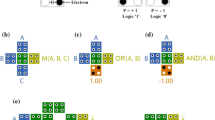Abstract
As the fabrication technology goes beyond nano-scale, the VLSI layout design using Complementary Metal Oxide Semiconductor (CMOS) becomes obsolete due to its short channel effects and leakage currents. Quantum-dot Cellular Automata (QCA) is a novel paradigm proposed to overcome the drawbacks of CMOS circuits at nano-scale. Complex arithmetical operations need accurate and fast computing architectures. Though performing arithmetical operations on fixed-point numbers is easy, however, floating-point numbers have significant advantages. Moreover, the operations on floating-point numbers decide the speed and accuracy of the arithmetic unit. Hence, it is crucial to design a precise computing architecture for floating-point numbers. This paper presents for the first time an optimized architecture using QCA technology for the addition of single-precision floating-point numbers. The proposed model has been designed with lesser number of blocks which have been proved to be the best among the existing models. The proposed floating-point adder is simulated using QCADesigner tool that requires 10,370 quantum cells in an area of 21.25 μm2 with a delay of 15 clock cycles. The energy dissipation analysis of proposed architecture is studied using QCA Designer-E tool based on which the power dissipation is also calculated. The proposed model has a power dissipation of 6.56 nW, which is an improvement of 98% compared to present CMOS technology.














Similar content being viewed by others
References:
ISO/IEC/IEEE International Standard—Floating-point arithmetic. In: ISO/IEC 60559:2020(E) IEEE Std 754–2019, pp1–86, 8 May 2020. Doi: https://doi.org/10.1109/IEEESTD.2020.9091348
Lent CS, Tougaw PD, Porod W, Bernstein GH (1993) Quantum cellular automata. Nanotechnology 4(1):49
Tougaw PD, Lent CS (1994) Logical devices implemented using quantum cellular automata. J Appl Phys 75(3):1818–1825
Ozbilen MM, Gok M (2008) A multi-precision floating-point adder. Res Microelectron Electron, IEEE, pp 117–120
Jaiswal MK, Cheung RCC, Balakrishnan M, Paul K (2014) Unified architecture for double/two-parallel single-precision floating-point adder. IEEE Trans Circuits Syst II Express Briefs 61(7):521–525
Jain J, Agrawal R (2015) Design and development of efficient reversible floating-point arithmetic unit. In: 2015 Fifth International Conference on Communication Systems and Network Technologies, IEEE , pp 811–815
Kaivani A, Ko S (2015) Floating-point butterfly architecture based on binary signed-digit representation. IEEE Trans Very Large Scale Integ VLSI Syst 24(3): 1208–1211
Liu W, Chen L, Wang C, O’Neill M, Lombardi F (2015) Design and analysis of inexact floating-point adders. IEEE Trans Comput 65(1):308–314
Haener T, Soeken M, Roetteler M, Svore KM (2018) Quantum circuits for floating-point arithmetic. International Conference on Reversible Computation. Springer, Cham, pp 162–174
Honda SJ (2019) Low power 32-bit floating-point adder/subtractor design using 50nm CMOS VLSI technology. Int J Innov Technol Explor Eng 8(10)
"IEEE Standard for Floating-Point Arithmetic. In: IEEE Std 754–2019 (Revision of IEEE 754–2008), pp1–84. Doi: https://doi.org/10.1109/IEEESTD.2019.8766229
Muller JM, Brisebarre N, De Dinechin F, Jeannerod CP, Lefevre V, Melquiond G, Revol N, Stehlé D, Torres S (2018) Handbook of floating-point arithmetic, vol. 1. Birkhäuser
Arunkumar GA, Sudha GF (2020) Novel optimized tree-based stack-type architecture for 2 n-bit comparator at nano-scale with energy dissipation analysis. J Supercomput, pp 1–22
Surya SS, Gudivada AA, Nandan D (2020) Systematic review on full-subtractor using quantum-dot cellular automata (QCA). In: Proceedings of International Conference on Recent Trends in Machine Learning, IoT, Smart Cities and Applications, pp 619–626. Springer, Singapore.
Abdullah-Al-Shafi M, Bahar AN (2018) An architecture of 2-dimensional 4-dot 2-electron QCA full adder and subtractor with energy dissipation study. Active Passive Electron Comp 2018
Jeon J-C (2020) Low-complexity QCA universal shift register design using multiplexer and D flip-flop based on electronic correlations. J Supercomput 76(8):6438–6452
Anantha Lakshmi AV, Sudha GF (2014) Design of a reversible single-precision floating-point subtractor. Springerplus 3(1):1–20
Gudivada AA, Sudha GF (2020) Design of Baugh-Wooley multiplier in quantum-dot cellular automata using a novel 1-bit full adder with power dissipation analysis. SN Appl Sci 2:813. https://doi.org/10.1007/s42452-020-2595-5
Author information
Authors and Affiliations
Corresponding author
Ethics declarations
Conflict of interest
The authors have no conflict of interest.
Additional information
Publisher's Note
Springer Nature remains neutral with regard to jurisdictional claims in published maps and institutional affiliations.
Rights and permissions
About this article
Cite this article
Gudivada, A.A., Sudha, G.F. Novel optimized low power design of single-precision floating-point adder using Quantum-dot Cellular Automata. J Supercomput 78, 6035–6053 (2022). https://doi.org/10.1007/s11227-021-04089-5
Accepted:
Published:
Issue Date:
DOI: https://doi.org/10.1007/s11227-021-04089-5




